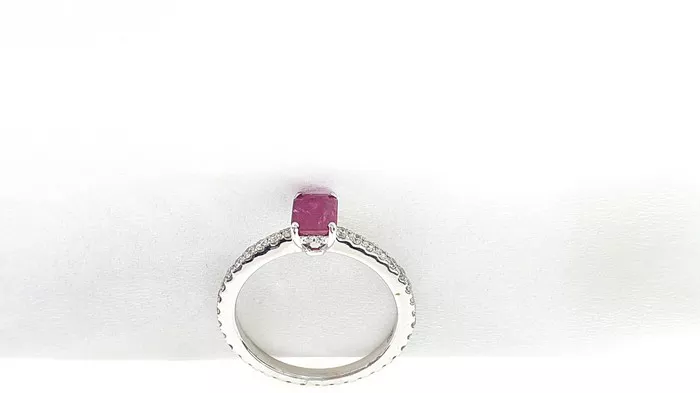Engagement rings symbolize a significant milestone in many cultures worldwide, serving as tangible representations of love, commitment, and unity. While the tradition of exchanging engagement rings spans centuries, the practice of incorporating diamonds into these cherished tokens is a relatively modern phenomenon. In this article, we delve into the intriguing history of diamonds in engagement rings, tracing their evolution from ancient customs to contemporary traditions.
Ancient Origins of Engagement Rituals
To comprehend the emergence of diamonds in engagement rings, it’s imperative to explore the origins of engagement rituals themselves. The exchange of rings as a pledge of betrothal dates back to ancient civilizations, with evidence found in cultures such as ancient Egypt, Greece, and Rome. These early rings were typically crafted from materials like woven reeds, leather, or simple metal bands, symbolizing the binding agreement between two individuals.
Evolution of Engagement Rings
The concept of engagement rings evolved over time, with varying customs and materials reflecting the cultural norms of different epochs. In medieval Europe, for instance, engagement rings often featured intricate designs, incorporating symbols such as clasped hands (known as “fede” rings) or initials. These rings, usually made of gold or silver, signified the formal agreement of marriage between two families.
The Advent of Diamonds
While precious gemstones were occasionally set into engagement rings throughout history, diamonds did not become synonymous with these tokens of love until relatively recently. The pivotal moment in this evolution can be traced back to the 15th century, with the discovery of diamond deposits in India. Initially revered for their rarity and beauty, diamonds captured the imagination of royalty and nobility across the globe.
The Influence of Archduke Maximilian
One of the earliest recorded instances of a diamond engagement ring can be attributed to Archduke Maximilian of Austria in 1477. On the occasion of his betrothal to Mary of Burgundy, Maximilian presented her with a ring featuring a diamond set in the shape of an “M,” symbolizing their union. This extravagant gesture set a precedent among European aristocracy, sparking a trend of using diamonds in engagement rings among the elite.
Diamonds in the Renaissance Era
During the Renaissance period, diamonds gained further prominence as symbols of wealth and status. Advances in gem-cutting techniques, notably the development of the rose cut, enhanced the brilliance and allure of diamonds, making them coveted treasures among the upper echelons of society. It was during this era that diamond engagement rings became increasingly fashionable among European aristocracy and affluent merchants.
The Rise of De Beers
The 19th century witnessed a transformative shift in the diamond industry with the establishment of De Beers Consolidated Mines Ltd. in South Africa. Founded by British businessman Cecil Rhodes, De Beers would come to dominate the global diamond market, implementing innovative marketing strategies to promote the allure of diamonds. Central to their campaign was the iconic slogan “A Diamond is Forever,” which emphasized the everlasting nature of love and commitment.
Diamonds in Popular Culture
The influence of popular culture played a significant role in cementing the association between diamonds and romance in the collective consciousness. In 1947, the De Beers advertising campaign featured in the iconic film “Gone with the Wind,” further perpetuating the notion that diamonds were indispensable symbols of love and devotion. Subsequent decades saw diamonds prominently featured in literature, music, and cinema, reinforcing their status as the quintessential choice for engagement rings.
The Modern Era of Diamond Engagement Rings
Today, diamond engagement rings remain the undisputed symbol of enduring love and commitment in many parts of the world. Advances in diamond cutting and setting techniques have led to a myriad of styles and designs, catering to diverse tastes and preferences. From classic solitaire settings to elaborate halo designs, the options are virtually limitless, allowing couples to express their unique bond in a meaningful and personal way.
Beyond Tradition: Alternative Options
While diamonds continue to reign supreme in the realm of engagement rings, there is a growing trend towards alternative gemstones and non-traditional designs. Gemstones such as sapphires, emeralds, and rubies offer a vibrant and distinctive alternative to diamonds, imbued with their own symbolism and significance. Likewise, unconventional ring styles incorporating mixed metals, intricate filigree, or vintage-inspired elements are gaining traction among couples seeking to break free from convention.
The Symbolism of Diamonds
Despite the emergence of alternative options, diamonds endure as timeless symbols of love, strength, and purity. Beyond their intrinsic beauty, diamonds are renowned for their durability and resilience, mirroring the enduring nature of true love. The rarity and preciousness of diamonds serve as a metaphor for the unique and irreplaceable bond shared between two individuals, making them an enduring choice for engagement rings.
Conclusion
The incorporation of diamonds into engagement rings represents a fascinating intersection of history, culture, and romance. From their humble origins in ancient customs to their ubiquitous presence in modern-day proposals, diamonds have evolved into iconic symbols of love and commitment. While the tradition continues to evolve with changing tastes and trends, the timeless allure of diamonds remains undiminished, ensuring their enduring legacy for generations to come.

